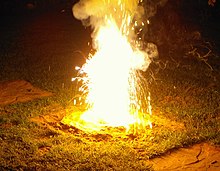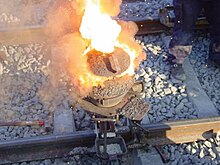Thermite reaction


The thermite reaction is a redox reaction , in which aluminum as a reducing agent is used to iron (III) oxide to iron to reduce . The mixture of aluminum powder and iron oxide powder used has the brand name Thermit . The reaction is very exothermic , i.e. with strong heat development. The reaction products are aluminum oxide and elemental iron in a glowing liquid state. The aluminum oxide floats on the iron. The reaction takes place, for example, in a clay crucible , barium peroxide with magnesium on a thermite lighter similar to a sparkler is used as an ignition agent .
Reaction sequence
The exothermic chemical reaction between iron oxide and aluminum, which is colloquially known as conversion, delivers liquid, low-carbon iron and liquid aluminum slag ( aluminum oxide , corundum ) at a temperature of approx. 2400 ° C :
The formation of Al 2 O 3 from the elements releases 1675.7 kJ / mol, and the formation of Fe 2 O 3 from the elements releases 824.2 kJ / mol:
For the formation of the Al 2 O 3 from the Fe 2 O 3 , it must first be broken down, and this requires 824.2 kJ / mol. When the Al 2 O 3 is formed , a total of only 1675.7 - 824.2 = 851.5 kJ / mol are released in this case.
One of the challenges with thermite welding is the severity of the reaction. To avoid it being so lively that the contents of the crucible boil over and both metal and slag are lost, non-magnetic hematite is often replaced with magnetic magnetite , which can be extracted from the scale of rolling mills :
In addition to iron and steel, other metals such as copper , nickel , titanium , chromium and manganese can be produced or added using the same process ( aluminothermics ) , e.g. B .:
history
The thermite process was developed in 1894 by the German chemist Hans Goldschmidt and is still used today for the aluminothermic welding of rail joints. As a landowner in Paulinenaue, Hans Goldschmidt ran a research workshop with welding and carpentry from 1918 until his death.
safety
Aluminothermic welding mixtures are not explosives and can only be converted ( ignited ) by a very high supply of heat ( activation energy ). The ignition temperature of the filler metal used for welding purposes is over 1500 ° C; this is achieved with a pyrotechnic lighter, but a simple magnesium rod can also provide the required energy and temperature. A gas burner with propane and oxygen is also suitable as a lighter. As a safety precaution, thermite welding compounds and lighter are stored separately so that in the event of a fire, any lighters that may burn do not fall into the welding compound.
The volume or weight related energy density (specific enthalpy ) of aluminothermic welding compounds is significantly lower than that of substances that burn with atmospheric oxygen (light metals, phosphorus, gasoline, benzene, napalm II ). Comparison: aluminothermic weld portions have about a quarter of the specific enthalpy of wood. This is due to the fact that the iron oxide contained in these portions does not provide any energy, but must first be broken down into metallic iron and oxygen ions, which requires a considerable amount of energy.
Since reacting aluminothermic sweat portions do not require external oxygen , the reaction cannot be stifled and ignited in any environment - even under sand or water - and continue to burn.
Extinguishing attempts with water and moisture lead to another redox reaction in which the water is reduced by the less noble metals and thus metal oxide and hydrogen are formed:
At these temperatures, the resulting hydrogen reacts with atmospheric oxygen to form water, which in turn reacts with aluminum and iron. The presence of water therefore represents a great danger in the aluminothermic reaction and leads to the explosive ejection of glowing substances as well as explosive hydrogen-oxygen mixtures ( oxyhydrogen ). Aluminothermic mixtures must therefore be stored dry. Welding points in track construction are usually heated to over 100 ° C beforehand with a gas burner in order to dry them.
Applications
The applications of aluminothermic reactions are diverse. The most common application is the reduction of iron (III) oxide , whereby temperatures of over 2000 ° C can be reached:
Thermit welding in track construction
Rails were first welded with thermite on the tram in Essen in 1899. A worldwide sales and manufacturing network was built up into the 1920s. In 1928 the Deutsche Reichsbahn introduced thermite welding as a standard welding process. Almost all other railroad companies in the world followed until after the Second World War.
Cast half-molds are attached to the sides of the rails, which are firmly aligned with a gap of around 2 cm, pressed with retaining plates and sealed with molding sand . The rail ends and the mold are then dried and preheated with a gas flame. The melting pot (nowadays often a fully filled, disposable metal bucket) with a fireclay lining is positioned exactly above the sprue . To be on the safe side, a fuse, a fuse with fuse or a fuse that has already been lit is added. Placing a crucible cap with a center hole insulates and protects against splashes while the powder mixture converts while smoking. In the past, casting was triggered manually, today it is usually triggered automatically by a melting stopper. The liquid steel runs into the mold, fills it and runs over riser channels, whereby the rail ends are slightly melted. After three minutes, the welding point has solidified to such an extent that the form can be removed and machining can begin by shearing off. When it cools down, the weld is roughly ground, the risers are removed and the driving surface is fine-tuned after it has cooled down. Additives like vanadium make the welding steel harder than the actual rail steel.
The aluminothermic cast fusion welding (abbreviation: AS) with short preheating (… -SkV) of a rail joint has several advantages: It is carried out with a relatively handy device and it does not use up the length of any rails that are already lying, because it brings liquid iron into the joint gap. It is also very useful on switches. - In welding plants, however, the alternative flash butt welding (RA) is more efficient.
The welding of rail joints results in a more stable track position, which reduces the monitoring and maintenance costs. In addition, seamlessly welded rails reduce the wheel-rail noise . The seamless welding of the rails to each other enables a reduction of the rail traffic noise by 6 dB (A).
Thermit welding as a repair welding process
Thermit welding was used with great success as a repair welding process until more effective welding processes were developed after the First World War .
weapons
Electron Thermitstäbe were in wars as incendiary bombs and incendiaries used.
In cooperation with the Schweizerische Aluminum Industrie Aktiengesellschaft (AIAG), the Swiss Army developed special aluminotherm processes to render various weapon systems unusable at the end of the 1940s.
Representation of other elements
The redox reaction with aluminum ( aluminothermy be) may also be used to make other metal oxides, or - ores , such as uranium , chromium (III) oxide , silica or manganese oxide to the respective metals or semi-metals reduce .
Demonstrations
Because of the impressive reaction with light effects and iron drops spraying around, thermite is used in show experiments. However, the thermite reaction is associated with considerable dangers, especially when moisture is present. See the Security section .
Explosion protection
A thermite reaction can also occur through vigorous mechanical contact if, for. B. beat rust-prone iron parts on aluminum. Sparks can be made that are able to ignite methane gas mixtures .
Individual evidence
- ↑ a b Stephan Kallee: Thermitschweißing - aluminothermic welding of railway tracks.
- ↑ a b Track construction world: Alu-Thermit welding.
- ↑ a b Peter W. Atkins and Julio de Paula, translated by Michael Bär: Physikalische Chemie 5th edition March 2013, Wiley-VCH, Weinheim, ISBN 978-3-527-33247-2 .
- ↑ a b Stephan Kallee: Thermit process around 1910 - One of the first independent publications on aluminothermic welding in America.
- ^ Richard N. Hart: The Thermit Process. In: Welding Theory, Practice, Apparatus and Tests. Electric, Thermit and Hot-Flame Processes. McGraw-Hill Book Company, London, 1910, pp. 152-153 and 121-158.
- ↑ Stephan Kallee: Aluminothermie - Aluminothermic welding of tram rails.
- ↑ Hans Goldschmidt: alumino-Thermics and Rail Welding. Abstract of lecture before the Columbia University Chemical Society, November 13, 1903.
- ↑ Paulinenaue as a science location . In: Paulinenaue. Accessed December 18, 2019 (German).
- ↑ Daniel Liebthal: Rail welding in perfection . In: The Railway Engineer . tape 71 , no. 3 , March 2020, ISSN 0013-2810 , p. 39-42 .
- ↑ Johannes Braun, Jörg Keichel and Andreas Peters: Aluminothermic welding: Tradition and innovation in the seamless track (Aluminothermic welding: tradition and innovation in continuously welded track). In: Infrastructure Network ZEVrail, No. 139, October 10, 2015, pp. 382–389.
- ^ Website Gleisbau-Welt (Memento from March 18, 2004 in the Internet Archive), welding process, Matthias Müller, Thorsten Schaeffer, 2003–2012, accessed April 20, 2019.
- ↑ Lothar Fendrich (Ed.): Manual Railway Infrastructure. Volume 10, Springer Berlin 2006, ISBN 3-540-29581-X , pp. 317-319.
- ↑ Berlin House of Representatives: Minor question from Claudia Hämmerling (Bündnis 90 / Die Grünen) from November 19, 2010 and answer Much ado about nothing at Karower Kreuz and how safe is the Szczecin Railway? (Printed matter 16/14 932).
- ↑ Stephan Kallee: Thermit in practice - first applications of aluminothermic welding in the USA until 1905.
- ^ Ernest Stütz: The Thermit Process in American Practice. Presented at the June 1905 meeting of the American Society for Testing Materials . In: The Iron and Steel Magazine, September 1905, pp. 212-221.
- ↑ Patent US5092921 .
- ↑ Patent US5152830 .
- ↑ Experiment 69: Thermit method. on: lp.uni-goettingen.de .
- ↑ circular order by Landesoberbergamt NRW no. 18.23.2-5-16, of 16 06 1984 systems.
- ↑ Technical rules for operational safety, TRBS 2152 Part 3. Dangerous explosive atmosphere - Avoiding the ignition of dangerous explosive atmosphere.













